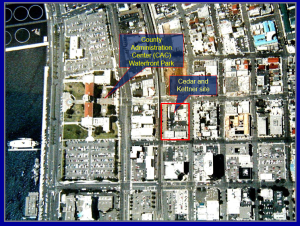2016 begins with San Diego looking at some pretty major changes. Downtown San Diego is experiencing a building boom and has community groups pushing for it be a walkable, bikeable city center. Awesome. The San Diego City Council recently unanimously voted to adopt a Climate Action Plan to ensure our city is a leader in moving to renewable energy and reducing emissions. The plan includes a goal to make biking 6% of commuter mode share by 2020 and 18% by 2035 (in select “Transit Priority Areas”). Currently the city is around 1% bicycle mode share. Aim high – great. Last week SANDAG held a meeting for public input regarding a bicycle / pedestrian bridge above Florida Street to connect Hillcrest and North Park. This week SANDAG holds a meeting for public comment regarding Pershing Drive and creating a high quality bike route from North Park to Downtown. Good stuff.

The tough bit about all these goals and plans – and there are many more great projects being proposed – is in making them a reality and backing up words and PowerPoints with actions and improvements on the ground. Roadway and infrastructure projects changes happen over years, if not decades. It is not a fast nor easy process and without consistent oversight and public pressure many, if not most, changes and projects will be scrapped a few years after being proprosed or passed. To see long-term, meaningful progress in making San Diego a world-leader for bicycling is why I support Bike San Diego.
Today I doubled my existing monthly contribution to the organization and I hope you’ll join me and make a recurring donation today.
I have found no organization in San Diego that more strongly and consistently is pushing for real, positive change on our roadways than Bike San Diego. If you want representation at public meetings, in meetings with elected officials and community groups, and ongoing leadership on the public stage I think you’ll find the same.
2015 was a tough year for biking in San Diego. The SANDAG Regional Bikeway Projects, announced in September 2013 with $200 million of funding, have yet to paint a single foot of bike lane more than 2 years later. The first project under this program, in Uptown, had the most critical portion – an East-West connection from Mission Hills to North Park – gutted despite many hours of meetings, and input from the communities to be improved. I attended many of the meetings for this project, and for a paired project in North Park, and have since wondered why I spent so much time, stress, and effort to see a unanimous vote against bike lanes by the Uptown Planners group. It has left me pondering if my time would be better spent elsewhere – if the “public outreach meetings” seem intentionally designed to give cover to the pre-ordained outcome as being community supported perhaps attendance is even counter-productive. Across the bay Coronado was widely panned for ludicrous commentary regarding bike lanes (video below).
My solace comes from the growing bicycling community in San Diego, and the support and leadership shown by Bike San Diego. We may have lost University Avenue (for now) but we showed up, spoke up, and connected. At the next set of meetings we’ll be bigger, louder, and more insistent on the outcome of public meetings truly reflecting the content of those meetings. When 70% of meeting testimony is strongly in support of a project the outcome should not be unanimous in the other direction. Such disrepect for the public can stand temporarily but over time will not.
Biking is critical to the future of San Diego, if we desire to be a city succeeding in the future. Look at world-class cities like London, Paris, New York City, Vancouver, Copenhagen, and others – they are embracing biking and walking and reaping immense economic rewards. The backwaters are not those that walk and bike – they are those that are tripling down on freeways and levelling neighborhoods to pave even more. Would San Francisco be more successful if four freeways were rammed through it or was the city right to demolish the freeway that long blighted the famed waterfront on the bay?
San Diego has no excuse to not be a world-leader in biking. We have the best weather in the United States. We stand to benefit economically, socially, and in health from increased levels of biking (and decreased levels of driving). We are a major city and should stop pretending we’re a congolmeration of suburbs with a mall as a city center. We need to get serious about real change on the ground. Bike San Diego will be there every step of the way but can not do it without support.
Please support Bike San Diego today and help create a better future for our city.


































